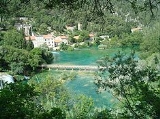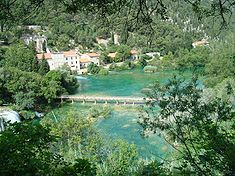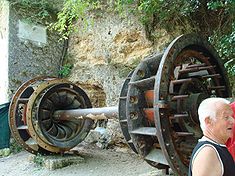
Jaruga Hydroelectric Power Plant
Encyclopedia
Jaruga Hydroelectric Power Plant is a hydroelectric power plant on river Krka
, located in Šibenik-Knin county
, in central Dalmatia
, Croatia
.
The Jaruga is one of the oldest power-generating facilities in the world. Its present location dates back to 1903, when it was moved from the nearby original Jaruga power station built in 1895.
 The oldest Jaruga power plant was the first alternating current
The oldest Jaruga power plant was the first alternating current
(AC) power system in Croatia, the first commercial hydro power plant in Europe
, and second in the world. It was set in operation on 28 August 1895 at 20:00, three days after the Adams Power Plant on the Niagara Falls. It was designed to power the street light
s in Šibenik
, making it the third city in the world with street lights powered by a polyphase system
of alternating current
(AC).
In 1893, the mayor of Šibenik Ante Šupuk
and one Vjekoslav Meichser started a business and obtained a license to use the waters of river Krka
, and in 1894 they obtained permission to set up electrical power lines on municipal property in order to start lighting the streets with electric power. The construction of Jaruga started in 1894 and lasted for 16 months.
The two generators
(42 Hz, 550 kW each) and the transformer
s were produced and installed by the Hungarian company Ganz
. The transmission line from the power plant to the city of Šibenik
was 11 km (6.8 mi) long on wooden towers, and the municipal distribution grid 3000V/110 V included six transformer stations.
The original Jaruga system supplied 340 street lights and some electrified houses in Šibenik.
Croatian Post printed a stamp commemorating this power plant in 1995. The Croatian national electricity company HEP
lists the same event and date as its origin and marks the date.
Three years after the first Jaruga was built, the construction of the second Jaruga hydro power plant began, the current location. It was completed in 1903 when its capacity was 6 MW.
Since its construction, the current Jaruga has been refurbished in 1916, 1937, 1970, 1995 and 2008, but the basic concept of the plant had been maintained. In 1936 a second generator was installed that increased the capacity to 5,6 MW.
 The Krka River rises under the travertine barrier of the Topolje waterfall near the town of Knin
The Krka River rises under the travertine barrier of the Topolje waterfall near the town of Knin
. Total length of the Krka River, from its spring
to its end in the Adriatic sea
near Skradin
is 56 km. Total Krka catchment area
is 2427 km2, of which 142 km2 is included in the Krka National park.
Along its course, the Krka receives a number of important tributaries. Some major among them are Krčić, Kosovčica, Orašnica, Butišnica, Miljacka, Čikola
, Goduča and Rivina Jaruga. The Jaruga power plant is the last one of five hydro power plants in the Krka catchment
, from its spring to the sea. It uses the gross head of about 26 m, which is a portion of the naturally concetrated head of about 45 m at the Skradinski buk waterfall. Visovačko jezero (lake) is upstream the waterfall and the Krka and Prokljansko jezero
(lake), affected by the sea backwaters, downstream.
This is a typical run-off-the-river plant of diversion type, with no possibility of water regulation. Total installed capacity
is 5.4 MW and average annual output 35 GWh. It is a minor power plant concerning both capacity and annual output. Also the most important use is to power or give energy to the park.

Krka (Croatia)
Krka is a river in Croatia's Dalmatia region, famous for its numerous waterfalls. It is long and its basin covers an area of .Possibly the river called Catarbates by the ancient Greeks, it was known to the ancient Romans as Titius, Corcoras, or Korkoras.The river has its source near the border...
, located in Šibenik-Knin county
Šibenik-Knin County
Šibenik-Knin County is a county in Croatia, located in north-central Dalmatia. Its center is Šibenik; other notable towns are Knin, Drniš and Skradin....
, in central Dalmatia
Dalmatia
Dalmatia is a historical region on the eastern coast of the Adriatic Sea. It stretches from the island of Rab in the northwest to the Bay of Kotor in the southeast. The hinterland, the Dalmatian Zagora, ranges from fifty kilometers in width in the north to just a few kilometers in the south....
, Croatia
Croatia
Croatia , officially the Republic of Croatia , is a unitary democratic parliamentary republic in Europe at the crossroads of the Mitteleuropa, the Balkans, and the Mediterranean. Its capital and largest city is Zagreb. The country is divided into 20 counties and the city of Zagreb. Croatia covers ...
.
The Jaruga is one of the oldest power-generating facilities in the world. Its present location dates back to 1903, when it was moved from the nearby original Jaruga power station built in 1895.
History

Alternating current
In alternating current the movement of electric charge periodically reverses direction. In direct current , the flow of electric charge is only in one direction....
(AC) power system in Croatia, the first commercial hydro power plant in Europe
Europe
Europe is, by convention, one of the world's seven continents. Comprising the westernmost peninsula of Eurasia, Europe is generally 'divided' from Asia to its east by the watershed divides of the Ural and Caucasus Mountains, the Ural River, the Caspian and Black Seas, and the waterways connecting...
, and second in the world. It was set in operation on 28 August 1895 at 20:00, three days after the Adams Power Plant on the Niagara Falls. It was designed to power the street light
Street light
A street light, lamppost, street lamp, light standard, or lamp standard is a raised source of light on the edge of a road or walkway, which is turned on or lit at a certain time every night. Modern lamps may also have light-sensitive photocells to turn them on at dusk, off at dawn, or activate...
s in Šibenik
Šibenik
Šibenik is a historic town in Croatia, with population of 51,553 . It is located in central Dalmatia where the river Krka flows into the Adriatic Sea...
, making it the third city in the world with street lights powered by a polyphase system
Polyphase system
A polyphase system is a means of distributing alternating current electrical power. Polyphase systems have three or more energized electrical conductors carrying alternating currents with a definite time offset between the voltage waves in each conductor. Polyphase systems are particularly useful...
of alternating current
Alternating current
In alternating current the movement of electric charge periodically reverses direction. In direct current , the flow of electric charge is only in one direction....
(AC).
In 1893, the mayor of Šibenik Ante Šupuk
Ante Supuk
Ante Šupuk was a Croatian engineer and inventor, also a mayor of Šibenik. In 1895 he built the first Jaruga Hydroelectric Power Plant as one of the world's first hydroelectric power plants, and connected it to a lighting system using alternating current...
and one Vjekoslav Meichser started a business and obtained a license to use the waters of river Krka
Krka (Croatia)
Krka is a river in Croatia's Dalmatia region, famous for its numerous waterfalls. It is long and its basin covers an area of .Possibly the river called Catarbates by the ancient Greeks, it was known to the ancient Romans as Titius, Corcoras, or Korkoras.The river has its source near the border...
, and in 1894 they obtained permission to set up electrical power lines on municipal property in order to start lighting the streets with electric power. The construction of Jaruga started in 1894 and lasted for 16 months.
The two generators
Electrical generator
In electricity generation, an electric generator is a device that converts mechanical energy to electrical energy. A generator forces electric charge to flow through an external electrical circuit. It is analogous to a water pump, which causes water to flow...
(42 Hz, 550 kW each) and the transformer
Transformer
A transformer is a device that transfers electrical energy from one circuit to another through inductively coupled conductors—the transformer's coils. A varying current in the first or primary winding creates a varying magnetic flux in the transformer's core and thus a varying magnetic field...
s were produced and installed by the Hungarian company Ganz
Ganz
The Ganz electric works in Budapest is probably best known for the manufacture of tramcars, but was also a pioneer in the application of three-phase alternating current to electric railways. Ganz also made / makes: ships , bridge steel structures , high voltage equipment...
. The transmission line from the power plant to the city of Šibenik
Šibenik
Šibenik is a historic town in Croatia, with population of 51,553 . It is located in central Dalmatia where the river Krka flows into the Adriatic Sea...
was 11 km (6.8 mi) long on wooden towers, and the municipal distribution grid 3000V/110 V included six transformer stations.
The original Jaruga system supplied 340 street lights and some electrified houses in Šibenik.
Croatian Post printed a stamp commemorating this power plant in 1995. The Croatian national electricity company HEP
Hrvatska elektroprivreda
Hrvatska elektroprivreda is a national power company in Croatia which has been engaged in electricity production, transmission and distribution for more than one century, and with heat supply and gas distribution for the past few decades...
lists the same event and date as its origin and marks the date.
Three years after the first Jaruga was built, the construction of the second Jaruga hydro power plant began, the current location. It was completed in 1903 when its capacity was 6 MW.
Since its construction, the current Jaruga has been refurbished in 1916, 1937, 1970, 1995 and 2008, but the basic concept of the plant had been maintained. In 1936 a second generator was installed that increased the capacity to 5,6 MW.
Catchment and capacity

Knin
Knin is a historical town in the Šibenik-Knin county of Croatia, located near the source of the river Krka at , in the Dalmatian hinterland, on the railroad Zagreb–Split. Knin rose to prominence twice in history, as a one-time capital of both the Kingdom of Croatia and briefly of the...
. Total length of the Krka River, from its spring
Spring (hydrosphere)
A spring—also known as a rising or resurgence—is a component of the hydrosphere. Specifically, it is any natural situation where water flows to the surface of the earth from underground...
to its end in the Adriatic sea
Adriatic Sea
The Adriatic Sea is a body of water separating the Italian Peninsula from the Balkan peninsula, and the system of the Apennine Mountains from that of the Dinaric Alps and adjacent ranges...
near Skradin
Skradin
Skradin is a small town in the Šibenik-Knin county of Croatia it has a population about 3,986 . It is located near the Krka river and at the entrance to the Krka National Park, from Šibenik and from Split...
is 56 km. Total Krka catchment area
Drainage basin
A drainage basin is an extent or an area of land where surface water from rain and melting snow or ice converges to a single point, usually the exit of the basin, where the waters join another waterbody, such as a river, lake, reservoir, estuary, wetland, sea, or ocean...
is 2427 km2, of which 142 km2 is included in the Krka National park.
Along its course, the Krka receives a number of important tributaries. Some major among them are Krčić, Kosovčica, Orašnica, Butišnica, Miljacka, Čikola
Čikola
Čikola is a river of 47.8 km in length, located in Dalmatia, southern Croatia.Čikola river's springs is near the village Čavoglave, flows through the city of Drniš and then flows near village of Miljevci into the river of Krka which flows into Adriatic Sea.-See also:*Krka*Krka National Park...
, Goduča and Rivina Jaruga. The Jaruga power plant is the last one of five hydro power plants in the Krka catchment
Drainage basin
A drainage basin is an extent or an area of land where surface water from rain and melting snow or ice converges to a single point, usually the exit of the basin, where the waters join another waterbody, such as a river, lake, reservoir, estuary, wetland, sea, or ocean...
, from its spring to the sea. It uses the gross head of about 26 m, which is a portion of the naturally concetrated head of about 45 m at the Skradinski buk waterfall. Visovačko jezero (lake) is upstream the waterfall and the Krka and Prokljansko jezero
Prokljansko jezero
Lake Prokljan is a lake in the Croatian region of Dalmatia, located near the cities of Skradin and Šibenik.- Geography :The lake is situated in the lower reaches of the river Krka, and it covers an area of . It is not entirely closed, but is connected to the sea by a narrow channel which leads to...
(lake), affected by the sea backwaters, downstream.
This is a typical run-off-the-river plant of diversion type, with no possibility of water regulation. Total installed capacity
Hydroelectricity
Hydroelectricity is the term referring to electricity generated by hydropower; the production of electrical power through the use of the gravitational force of falling or flowing water. It is the most widely used form of renewable energy...
is 5.4 MW and average annual output 35 GWh. It is a minor power plant concerning both capacity and annual output. Also the most important use is to power or give energy to the park.
The Krka River catchment hydroelectric power plants

- Golubić Hydroelectric Power PlantGolubic Hydroelectric Power PlantGolubić Hydroelectric Power Plant is a hydroelectric power plant on river Butiznica located in Šibenik-Knin county, in central Dalmatia, Croatia....
- Small Krčić Hydroelectric Power PlantSmall Krcic Hydroelectric Power PlantKrčić Hydroelectric Power Plant is a hydroelectric power plant on river Krka, located in Šibenik-Knin County, in central Dalmatia, Croatia....
- Miljacka Hydroelectric Power PlantMiljacka Hydroelectric Power PlantMiljacka Hydroelectric Power Plant is a hydroelectric power plant on the river Krka, located in Šibenik-Knin county, in central Dalmatia, Croatia....
- Roški Slap Hydroelectric Power PlantRoški Slap Hydroelectric Power PlantRoški Slap Hydroelectric Power Plant is a hydroelectric power plant on river Krka, located in Šibenik-Knin county, in central Dalmatia, Croatia.The Roški Slap - Hydroelectric Power Plant is a very small power plant of only 1MW...
- Jaruga Hydroelectric Power Plant
External links
- http://www.ieee.org/web/aboutus/history_center/conferences/che2007/prog_comm.html
- http://www.croatia.ch/zanimljivosti/070812.php

